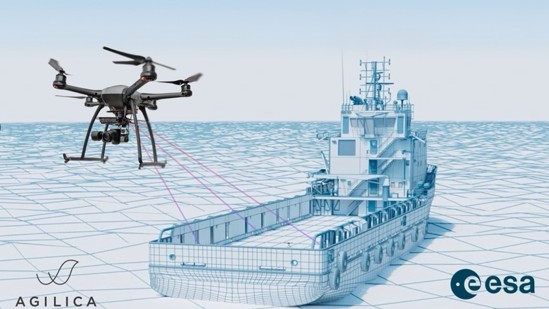Agilica BV, a spin-out from the Royal Military Academy of Belgium, has successfully completed a European Space Agency (ESA)-funded feasibility study to develop an alternative positioning, navigation, timing (PTN) system enabling precision drone navigation and landing in environments where global navigation satellite system (GNSS) signals are degraded or unavailable.
“This represents a critical step on the commercialisation roadmap of Agilica’s core product — the AGL system — by adding built-in compatibility with GNSS and Galileo High Accuracy Service (HAS) to their Ultra-Wideband (UWB) positioning solution for drones in the maritime, logistics, and urban air mobility sectors,” said the company in a press release.
“The ESA-backed study validates the technical and commercial viability of the AGL system integrating GNSS receivers into the infrastructure for seamless transition to and from GNSS in high-impact applications, including drone landings on moving vessels, operations in indoor facilities, and autonomous deliveries in complex urban or offshore environments.
“Landing a drone on a moving ship in dynamic conditions is one of the toughest challenges in drone autonomy. Our AGL system is built to solve this — not by replacing GNSS, but by augmenting it,” said Bart Scheers, Agilica’s COO and lead on the project. “This feasibility study confirms that our patented UWB approach can extend PNT services, with sub-20 cm precision in GNSS-denied zones.”
“The AGL system, built on patented time-of-flight UWB technology, functions like a dedicated terrestrial GNSS network — delivering centimetre-level accuracy and resilience in metallic, weather-challenged, or GNSS-compromised environments where vision-based systems and QR codes fall short. Anchors, which can now be equipped with GNSS receivers and precision timing, form the fixed infrastructure, while mobile tags integrated into drones enable autonomous, precision-guided landings — even indoors or at sea.”
According to the company the ESA feasibility study enabled Agilica to validate the key functionality of seamless transition from GNSS to the AGL system in collaboration with stakeholders from drone logistics, offshore energy, and eVTOL sectors; identify the market opportunities worth over EUR1.9 billion globally; and outline an initial commercial strategy that prioritises interoperability with service providers and OEM partners
Agilica is now actively engaging with drone OEMs, logistics firms, AAM/eVTOL manufacturers, and maritime autonomy providers to move toward live demonstration projects.
For more information




